Memories of the Quit India Movement
at Dhekiajuli
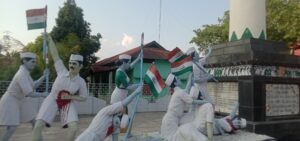
Some places of India’s freedom struggle dwell in our consciousness – Jallianwala Bagh for instance or Gowalia Tank Maidan, Jhansi and Meerat and Chauri Chaura. But there are many other places scattered across the country marked by Shaheed Minars and Hutatma Smaraks which remain unknown to the world, whose stories remain alive only to local people. We happened to experience one such place last month at Dhekiajuli – a small town in Shonitpur district of Assam.
We (Kalyan, Ruchika and I along with Adv. Farhat Baig, Farha and Yerzan) were travelling from Guwahati in Assam to Tenga Valley in Arunachal Pradesh on the NH15. All around us was the tremendous greenery of the North East. We crossed small houses with typical sloping roofs, each one with a neat flower garden and often with a fish pond. Banana fronds and coconut palms swayed in the breeze. We crossed a weekly market and roadside shops with all things made of bamboo – from mats and baskets to wall hangings and flower pots, furniture and purses. Women in the traditional Mekhla-Chador went about their daily chores, some wore shirts with shawls tied around their chests. Assam had the feel of nature’s bounty, an overwhelming lush verdure that brings a certain drowsiness.
Four hours into the drive we were crossing what appeared to be a small town – perhaps a Tehsil town or a sub-division. We were in the market area of Dhekiajuli town.
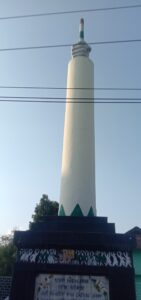
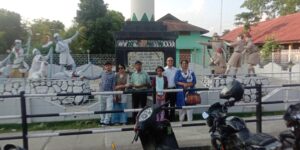
Right next to the busy roadside was a Shahid Minar with two groups of statues on either side of the central monument. On the right were a group of policemen in British uniforms with rifles and on the left were Indian men and women bleeding from bullet wounds with tricolour in their hands. The statues were so life-like that we could only stand there for a long time. We could hear the shots that were fired, we could hear the chaos in the market and we could hear the Mahatma Gandhi ki Jai, Bharat Mata ki Jai. We requested a person there to read out to us the lines written in Assamese on a tablet at the bottom of the tower – Stop a moment passer-by and remember the sacrifice…
Inside Dhekiajuli Heritage Police Station
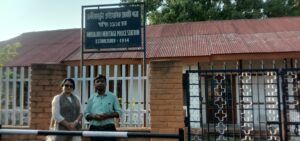
Right next two the Shahid Minar was a newly-painted and repaired house that appeared closed. We found a board that said that this was the Old Dhekiajuli Police Station built in 1914. On 20 September, 1942 during the Quit India movement a group of Congress Volunteers led by Kamalkanti Das, Phanidhar Das and Bapuram Gogoi organised a peaceful rally to hoist the Tricolour on the police station . The police opened fire in which thirteen people died. Their names are given as Manbar Nath, Kumli Devi, Khahuli Devi, Tileswari Barua, Ratan Kachari, Maniram Kachari, Lerela Kachari, Mangal Kurku, Mahiram Koch, Sarunath Chetia, Dayal Das Panika. Inspite of the bloodshed the patriots were able to lower the Union Jack and hoist the Tricolour in its place.
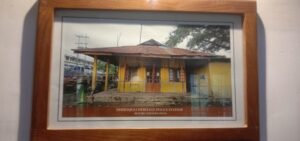
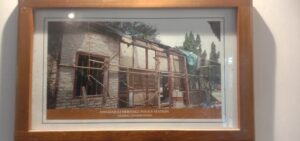
We entered the gates of the police station and found the Lock-up No.1 open. Then we peeped through a glass window and realised that the old Thana had been converted into a museum. Someone went around and found the entrance at the back. We entered the empty Police Station which must have been once a busy Chowki. It took very little to imagine the Inspector and the Constabulary going about their official work. There was another Lock-up No.2 inside and a third lock-up outside. We entered the lock-ups – it gave an eerie feeling of the past.
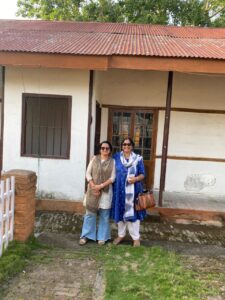
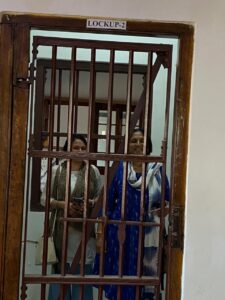
Photographs of the renovation process were on the walls along with pictures of the martyrs. There was detailed information about the procession and the firing incident of the fateful day.
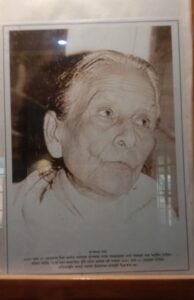
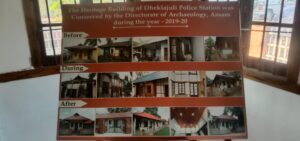
The Directorate of Archeology, Government of Assam had done a good job of renovating and maintaining the place.
The struggle at Dhekiajuli has an uncanny resemblance to the freedom struggle at Chimur. In both places people responded to the ‘Do or Die’ call of 1942. In both places people rallied towards the police station. In both places police opened fire killing freedom fighters. In both places the Tricolour was hoisted and the Union Jack lowered. From Dhekiajuli in Assam to Chimur in Maharashtra it is the same story, and the same story repeated in many other known and unknown corners of the country. Amidst news of communal riots and violence everyday, it is sobering to think about the common message of love that these spaces contain for all of us.
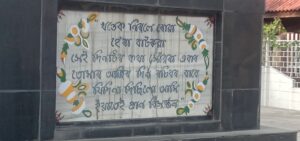
- Paromita Goswami
- Pics: Adv. Kalyan Kumar, Adv. Farhat Baig, Paromita Goswami
from WordPress https://ift.tt/MFJ3YKA
via IFTTT
Memories of the Quit India Movement
at Dhekiajuli

Some places of India’s freedom struggle dwell in our consciousness – Jallianwala Bagh for instance or Gowalia Tank Maidan, Jhansi and Meerat and Chauri Chaura. But there are many other places scattered across the country marked by Shaheed Minars and Hutatma Smaraks which remain unknown to the world, whose stories remain alive only to local people. We happened to experience one such place last month at Dhekiajuli – a small town in Shonitpur district of Assam.
We (Kalyan, Ruchika and I along with Adv. Farhat Baig, Farha and Yerzan) were travelling from Guwahati in Assam to Tenga Valley in Arunachal Pradesh on the NH15. All around us was the tremendous greenery of the North East. We crossed small houses with typical sloping roofs, each one with a neat flower garden and often with a fish pond. Banana fronds and coconut palms swayed in the breeze. We crossed a weekly market and roadside shops with all things made of bamboo – from mats and baskets to wall hangings and flower pots, furniture and purses. Women in the traditional Mekhla-Chador went about their daily chores, some wore shirts with shawls tied around their chests. Assam had the feel of nature’s bounty, an overwhelming lush verdure that brings a certain drowsiness.
Four hours into the drive we were crossing what appeared to be a small town – perhaps a Tehsil town or a sub-division. We were in the market area of Dhekiajuli town.


Right next to the busy roadside was a Shahid Minar with two groups of statues on either side of the central monument. On the right were a group of policemen in British uniforms with rifles and on the left were Indian men and women bleeding from bullet wounds with tricolour in their hands. The statues were so life-like that we could only stand there for a long time. We could hear the shots that were fired, we could hear the chaos in the market and we could hear the Mahatma Gandhi ki Jai, Bharat Mata ki Jai. We requested a person there to read out to us the lines written in Assamese on a tablet at the bottom of the tower – Stop a moment passer-by and remember the sacrifice…
Inside Dhekiajuli Heritage Police Station

Right next two the Shahid Minar was a newly-painted and repaired house that appeared closed. We found a board that said that this was the Old Dhekiajuli Police Station built in 1914. On 20 September, 1942 during the Quit India movement a group of Congress Volunteers led by Kamalkanti Das, Phanidhar Das and Bapuram Gogoi organised a peaceful rally to hoist the Tricolour on the police station . The police opened fire in which thirteen people died. Their names are given as Manbar Nath, Kumli Devi, Khahuli Devi, Tileswari Barua, Ratan Kachari, Maniram Kachari, Lerela Kachari, Mangal Kurku, Mahiram Koch, Sarunath Chetia, Dayal Das Panika. Inspite of the bloodshed the patriots were able to lower the Union Jack and hoist the Tricolour in its place.


We entered the gates of the police station and found the Lock-up No.1 open. Then we peeped through a glass window and realised that the old Thana had been converted into a museum. Someone went around and found the entrance at the back. We entered the empty Police Station which must have been once a busy Chowki. It took very little to imagine the Inspector and the Constabulary going about their official work. There was another Lock-up No.2 inside and a third lock-up outside. We entered the lock-ups – it gave an eerie feeling of the past.


Photographs of the renovation process were on the walls along with pictures of the martyrs. There was detailed information about the procession and the firing incident of the fateful day.


The Directorate of Archeology, Government of Assam had done a good job of renovating and maintaining the place.
The struggle at Dhekiajuli has an uncanny resemblance to the freedom struggle at Chimur. In both places people responded to the ‘Do or Die’ call of 1942. In both places people rallied towards the police station. In both places police opened fire killing freedom fighters. In both places the Tricolour was hoisted and the Union Jack lowered. From Dhekiajuli in Assam to Chimur in Maharashtra it is the same story, and the same story repeated in many other known and unknown corners of the country. Amidst news of communal riots and violence everyday, it is sobering to think about the common message of love that these spaces contain for all of us.

- Paromita Goswami
- Pics: Adv. Kalyan Kumar, Adv. Farhat Baig, Paromita Goswami





0 Comments